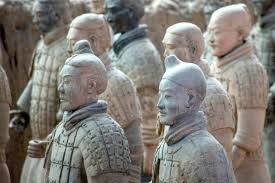
Are the Terracotta Warriors Real?
The Terracotta Army, a mesmerizing collection of life-size terracotta sculptures depicting the armies of Qin Shi Huang, the first emperor of China, often raises questions about their authenticity. Are these intricate figures truly from ancient China, or are they elaborate replicas?
The Terracotta Army: An Overview
Located in Lintong District, Xi'an, Shaanxi province, about 1.5 kilometers east of the Mausoleum of the First Qin Emperor, the Terracotta Army is a designated UNESCO World Heritage site and a testament to the grandeur and might of the Qin dynasty. Discovered in 1974 by farmers digging a well, the site consists of three main pits containing thousands of unique terracotta figures, including warriors, chariots, horses, and other artifacts.
Evidence of Authenticity
Several pieces of evidence solidify the Terracotta Army's authenticity as remnants of ancient China:
- Archaeological Context: The meticulous excavation and documentation of the site, along with the presence of other artifacts like weapons, pottery, and architectural remains, strongly suggest an authentic historical context.
- Radiocarbon Dating: Scientific dating methods, like radiocarbon dating, have been applied to organic materials found within the pits, confirming their creation around the late third century BC, aligning with the Qin dynasty.
- Historical Records: While no specific mention of the Terracotta Army exists, historical texts describe Qin Shi Huang's elaborate burial plans, including the creation of an army to protect him in the afterlife.
- Stylistic and Technological Analysis: The unique artistic style, manufacturing techniques, and materials used in creating the figures are consistent with other artifacts from the Qin dynasty, demonstrating continuity and authenticity.
Significance and Impact
Since their discovery, the Terracotta Army has captivated the world and drawn millions of visitors. Their existence provides invaluable insights into the military organization, warfare tactics, art, culture, and beliefs of the Qin dynasty, offering a window into a pivotal period in Chinese history.
Frequently Asked Questions
1. Are the Terracotta Warriors hollow?
Yes, most of the Terracotta Warriors are hollow. This construction technique helped to reduce the weight of the figures, making them easier to fire in kilns and assemble in the pits.
2. Were the Terracotta Warriors painted?
Yes, originally, the Terracotta Warriors were brightly painted with vibrant pigments. However, exposure to air and elements over centuries caused the paint to flake off, leaving them in their current, mostly earthen tones.
3. Why was the Terracotta Army built?
The Terracotta Army was built to accompany Qin Shi Huang in the afterlife. They served as a symbolic army to protect the emperor and showcase his power and authority even in death.